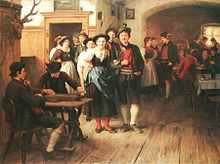Schuhplattler
 Vor dem Tanz, Franz Defregger (1835–1921) | |
| Genre | Social dance, folk dance |
|---|---|
| Time signature | 3/4 |
| Country | Bavaria, Germany and Austria |
The Schuhplattler is a traditional folk dance popular in the Alpine regions of Bavaria and Austria. It evolved from the Ländler.
Origins

The origins of this social dance are found in an early courtship display (Balztanz). Such a dance was described in 1050 by a monk of Tegernsee Abbey in the knightly poem Ruodlieb, wherein similar postures and movements of the Schuhplatter are depicted. The homelands of the Schuhplattler dance are the Northern Limestone Alps (Bavarian Prealps, Chiemgau and Berchtesgaden Alps) of Upper Bavaria (Germany) and the adjacent Austrian states of Tyrol and Salzburg, down to South Tyrol and the Drava Valley in Carinthia .
Style
In days gone by, young men wished to impress marriageable young ladies with their dancing prowess. Initially the style, allegedly an imitation of capercaillie courting, was free without rules. Performed usually in the 3/4 time of a Ländler, one would carry out a series of jumps and hip movements to the time of the music. Characteristically the male dancers will rhythmically strike their thighs, knees and soles (platteln), clap their hands (paschen), and stamp with their feet.
The former partner dance is nowadays usually performed by men only, often in the context of tradition shows by Trachten societies which maintain established Austro-Bavarian costumes and songs (Volksmusik). In turn, several female and also gay dancers (Schwuhplattler) have established own associations.
See also
- Legényes
- Verbunkos
- Allemande
- German dance
- Austrian folk dance
- Waltz
- Zwiefacher
References
External links
- Bayerischer Heimat- und Trachtenverein "Golden Gate" (English)
- Gauverband1 (German)
- Gauverband Nord Amerika (English)
- Geschichte des Schuhplattlers (German)
- GTEV Schlierachtaler Stamm (English)
- Holzhacker Plattler - Tegernsee (German)
- Pichler Voigasplattler (German)
- Schuhplattlergruppe Kohlrösl-Buam Gitschtal (German)
- Schuhplattlergruppe Tramin - Südtirol (German)
- The Gemuetlichen Schuhplattler of Anaheim, California (English)
| ||||||||||||||||||